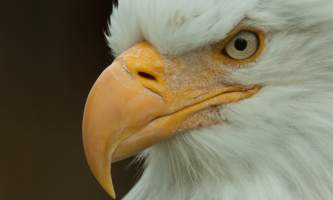Birds
The Alaska Wildlife Conservation Center is also home to a variety of birds. While visiting the sanctuary, it is also common to see a variety of bald eagles, ducks, rufous hummingbirds, ravens, magpies, Steller’s Jays, chickadees, nuthatches, redpolls, woodpeckers, trumpeter swans, snow buntings, sandhill cranes and mew gulls.
Let’s chat about eagles first.
There are an estimated 30,000 bald eagles in Alaska. Bald eagles are protected by both the Migratory Bird Treaty Act and the Bald and Golden Eagle Protection Act which prohibits the possession of eagles or their parts unless authorized by permit. Bald eagles are a species that is susceptible to the effects of clear-cut logging as large, old-growth trees are necessary for nesting in Southeast Alaska. Human disturbance to salmon spawning streams can also have detrimental effects on bald eagles. Recognizing this, The Alaska State Legislature established the Alaska Chilkat Bald Eagle Preserve, which protects 48,000 acres along the Chilkat River in southeast Alaska where upwards of 3,000 bald eagles congregate every winter to feast on salmon.
Credited largely to their amazing eyesight, Bald Eagles are phenomenally well-adapted predators in the state of Alaska. It is a well-known fact that Bald Eagles can see something as small as a several-pound salmon, mid-stream, from over a mile away, mid-flight.
Now, let’s talk about owls!
Like bald eagles, great horned owls have a strong sense of sight. The eyes of great horned owls are conical, not spherical, in shape and are held in place by round bones surrounding the narrow end of their conical shaped eye. Owls cannot move their eyes around in their socket like a human can, instead they can turn their head about ¾ of the way around in the other direction to see their surroundings. This is accomplished with 14 neck vertebrae; most mammals have only 7 vertebrae in the neck and large blood passageways. Their eyes are also huge! Proportionally, if humans’ eyes were as large as the great horned owls’ they would be the same size as a grapefruit or softball.


